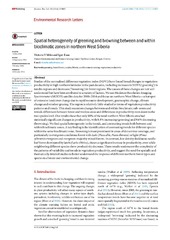| dc.contributor.author | Miles, Victoria | |
| dc.contributor.author | Esau, Igor | |
| dc.date.accessioned | 2017-01-12T14:40:28Z | |
| dc.date.available | 2017-01-12T14:40:28Z | |
| dc.date.issued | 2016-10-26 | |
| dc.Published | Environmental Research Letters 2016, 11(115002) | eng |
| dc.identifier.issn | 1748-9326 | |
| dc.identifier.uri | https://hdl.handle.net/1956/15364 | |
| dc.description.abstract | Studies of the normalized difference vegetation index (NDVI) have found broad changes in vegetation productivity in high northern latitudes in the past decades, including increases in NDVI (‘greening’) in tundra regions and decreases (‘browning’) in forest regions. The causes of these changes are not well understood but have been attributed to a variety of factors.Weuse Moderate Resolution Imaging Spectrometer (MODIS) satellite data for 2000–2014 and focus on northern West Siberia—a hot spot of extensive landcover change due to rapid resource development, geomorphic change, climate change and reindeer grazing. The region is relatively little-studied in terms of vegetation productivity patterns and trends. This study examines changes between and within bioclimatic sub-zones and reveals differences between forest and treeless areas and differences in productivity even down to the tree species level. Our results show that only 18% of the total northern West Siberia area had statistically significant changes in productivity, with 8.4% increasing (greening) and 9.6% decreasing (browning).We find spatial heterogeneity in the trends, and contrasting trends both between and within bioclimatic zones. A key finding is the identification of contrasting trends for different species within the same bioclimatic zone. Browning is most prominent in areas of denser tree coverage, and particularly in evergreen coniferous forest with dark (Picea abie, Picea obovata) or light (Pinus sylvestris) evergreen and evergreen-majority mixed forests. In contrast, low density deciduous needleleaf forest dominated by larch (Larix sibirica), shows a significant increase in productivity, even while neighboring different species show productivity decrease. These results underscore the complexity of the patterns of variability and trends in vegetation productivity, and suggest the need for spatially and thematically detailed studies to better understand the response of different northern forest types and species to climate and environmental change. | en_US |
| dc.language.iso | eng | eng |
| dc.publisher | IOP Publishing | eng |
| dc.rights.uri | http://creativecommons.org/licenses/by/3.0/ | eng |
| dc.subject | greening | eng |
| dc.subject | boreal forest | eng |
| dc.subject | tundra | eng |
| dc.subject | Siberia | eng |
| dc.subject | satellite remote sensing | eng |
| dc.subject | vegetation productivity | eng |
| dc.title | Spatial heterogeneity of greening and browning between and within bioclimatic zones in northern West Siberia | eng |
| dc.type | Journal article | eng |
| dc.type | Peer reviewed | eng |
| dc.date.updated | 2016-11-29T12:46:48Z | |
| dc.description.version | publishedVersion | |
| dc.rights.holder | Copyright 2016 IOP Publishing Ltd | eng |
| dc.identifier.doi | https://doi.org/10.1088/1748-9326/11/11/115002 | |
| dc.identifier.cristin | 1405747 | |

